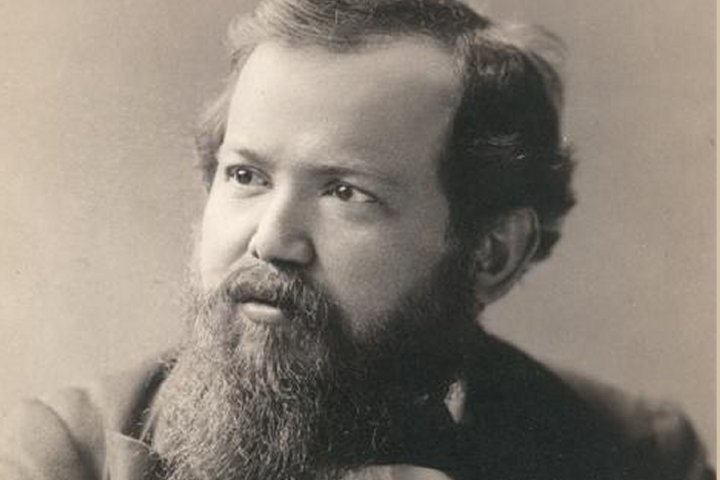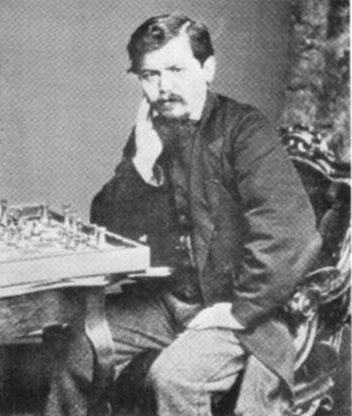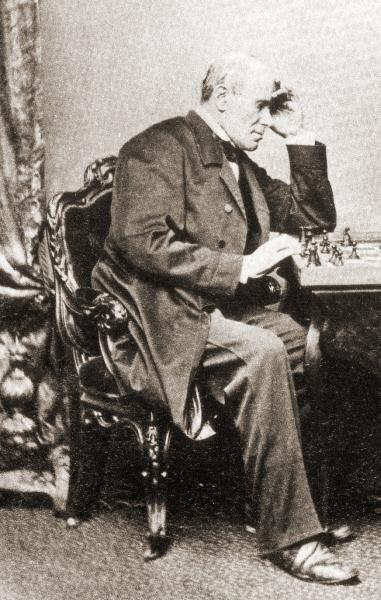


William Steinitz, the first official World Chess Champion, is considered the founder of the so-called "modern" school. Some chess players blame him for having swept away the romantic style of play by popularizing an approach that fearfully sticks to every single pawn instead of generously sacrificing pawns and pieces to attack the adverse king. But we should not forget that for many years Steinitz was a romantic chess player himself. His games until 1872 clearly prove this fact. I would like to deal with this first phase of his chess career.
William Steinitz was born on May 14th, 1836 in Prague, a city which at that time was part of the Austro-Hungarian Empire. At the age of twelve he learned chess from a schoolmate. Soon he defeated his teacher and after eager study of the game he could successfully compete with the Prague coffee house players. His parents wanted Steinitz to be a rabbi, but instead he went to Vienna in 1858 to study mathematics. He also wrote articles for a newspaper, but was increasingly interested in making a living as a feared coffee-house player. Soon he was so successful that he decided to become a chess professional.
The best conditions for professional chess players were offered by the English capital London. So Steinitz settled there in 1862, as did Johannes Hermann Zukertort ten years later. In 1862, 14 participants competed against each other in an international chess tournament. Sand timers were used and the time control was two hours for 20 moves each. Drawn games had to be repeated so often, until a winner was determined. Steinitz scored only 6 out of 13 and finished sixth. Adolph Anderssen won the tournament convincingly with 11 out of 13 ahead of Louis Paulsen (9). Both Anderssen and Paulsen won their games against Steinitz. Anderssen was 44 years old, Steinitz 18 years younger. Four years later they should meet again in a match.

Steinitz was not impressed by the mixed start of his international tournament career. Soon he showed himself superior to all English chess players. He proved to be most successful in matches. Already Morphy had masterfully understood how to adjust to an opponent. In Paris in 1858, Morphy had lost a casual game and two consecutive match games against Harrwitz. Then he predicted that Harrwitz would not win another game, and that was exactly what happened. And Steinitz, the "Austrian Morphy" followed his footsteps. In 1862/63 he defeated Joseph Henry Blackburne 7:1 with two draws. He also remained victorious in matches against Serafino Dubois, Frederic Deacon and Valentine Green. In 1866 the Englishman Henry Edward Bird performed comparatively best. Although Steinitz took the initiative from the beginning and was constantly in the lead since winning the first game, the final result was "only" 7:5 with 5 draws.
 In 1866 Steinitz achieved his biggest success so far in a match against Adolph Anderssen (pictured). The German chess champion had won the first international chess tournament (London 1851), but suffered a defeat in a match with Paul Morphy in 1858 (2:7 with two draws). Anderssen had dominated the London 1862 tournament and had shown himself superior to Steinitz. He also took a 1:0 lead in the match played in London from July 18th, to August 10th, but then suffered four defeats in a row. Surprisingly, Steinitz lost the next four games. But of the following five games, the 48-year-old German champion won only one and Steinitz four. The final result was 8:6 in favour of Steinitz. None of the 14 games ended up as a draw! From now on, Steinitz regarded himself as a world champion because he had defeated the player who, after Paul Morphy's withdrawal, was once again considered the strongest player in the world. Morphy had not participated in tournaments or matches since 1860. What a pity that he did not play a match against Steinitz! It would certainly have been very exciting.
In 1866 Steinitz achieved his biggest success so far in a match against Adolph Anderssen (pictured). The German chess champion had won the first international chess tournament (London 1851), but suffered a defeat in a match with Paul Morphy in 1858 (2:7 with two draws). Anderssen had dominated the London 1862 tournament and had shown himself superior to Steinitz. He also took a 1:0 lead in the match played in London from July 18th, to August 10th, but then suffered four defeats in a row. Surprisingly, Steinitz lost the next four games. But of the following five games, the 48-year-old German champion won only one and Steinitz four. The final result was 8:6 in favour of Steinitz. None of the 14 games ended up as a draw! From now on, Steinitz regarded himself as a world champion because he had defeated the player who, after Paul Morphy's withdrawal, was once again considered the strongest player in the world. Morphy had not participated in tournaments or matches since 1860. What a pity that he did not play a match against Steinitz! It would certainly have been very exciting.
A major international tournament took place in Paris in 1867. The time control was 10 moves per hour, but for 20 francs the players could buy 15 minutes extra time. Drawn games had to be repeated. Steinitz came in third behind v. Kolisch and Winawer. In Baden-Baden in 1870 Adolph Anderssen won first prize with 11 out of 16. Steinitz was second only half a point behind followed by Gustav Richard Neumann and Joseph Henry Blackburne (10 each). In this tournament Anderssen returned the favour for the match defeat four years earlier by winning both games against Steinitz. In Vienna, in 1873, we see for the first time another William Steinitz, who avoids the romantic style of play and tries a different strategy. Steinitz was successful winning not only the tournament, but also both games against Adolph Anderssen.
Steinitz and his later World Championship contender Johannes Herrmann Zukertort met for the first time at a tournament in London in 1872. Here, too, drawn games had to be repeated. Steinitz won the second game against Zukertort as well as all other six games and triumphed with a dream result of 7:0. Blackburne came in second, Zukertort, MacDonnell and de Vere tied for 3rd place.
After this tournament a match between Steinitz and Zukertort was arranged. They had to play for seven wins, drawn games did not count. The match lasted from August 6th, to September 5th, and was again held in London. Steinitz won the first two games. Zukertort was able to draw the next two games, but then lost again two games in a row. After another draw Zukertort scored his first win, but this should remain his only one, because Steinitz won three of the next four games. The final result was 7:1. Four games had ended in a draw. Some London chess friends had brought Zukertort to England with the motive to defeat Steinitz, but obviously their plan failed.
It is remarkable that the "romantic" Steinitz had become number 1 in the chess world. He had not only beaten Anderssen, Zukertort and Blackburne, but also all the other strong masters who had competed with him. And all this happened in a "romantic" playing style with gambits, daring sacrifices and king attacks. The fact that Steinitz was "only" third in Paris in 1867 and "only" second in Baden-Baden in 1870 is said to have been one of the reasons why he subjected his games played so far to a critical analysis. What came out of it and what consequences this had shall the subject of a separate article. But there is one thing we should not forget in this context: When Steinitz changed his playing style in 1873, he was already 37 years old. Most grandmasters have already passed their peak at this age. If Steinitz had died young or had retired from chess before the Vienna tournament of 1873, he would have made history as a typical representative of romantic chess.
Fortunately, many games of the "romantic" Steinitz have been preserved. The ChessBase Mega Database contains about 250 of his games played between 1859 and 1872. In many of them we see the typical openings of that time like King's Gambit, Evans Gambit, Giuoco Piano or the Vienna Game with an early f4. But Steinitz also played risky gambits with Black like 1.e4 e5 2.♗c4 f5?! We discover correct and incorrect sacrifices, solid as well as unsound attacks and even king hunts over the whole board. In game 6, for example, we see Steinitz forcing the adverse King from g1 to h7 to checkmate him there. Even more curious is the voluntary white king walk on a full board from e1 to a3 in front of his own pawns in a game against J. H. Zukertort (No. 8). I selected ten games and commented on two of them.